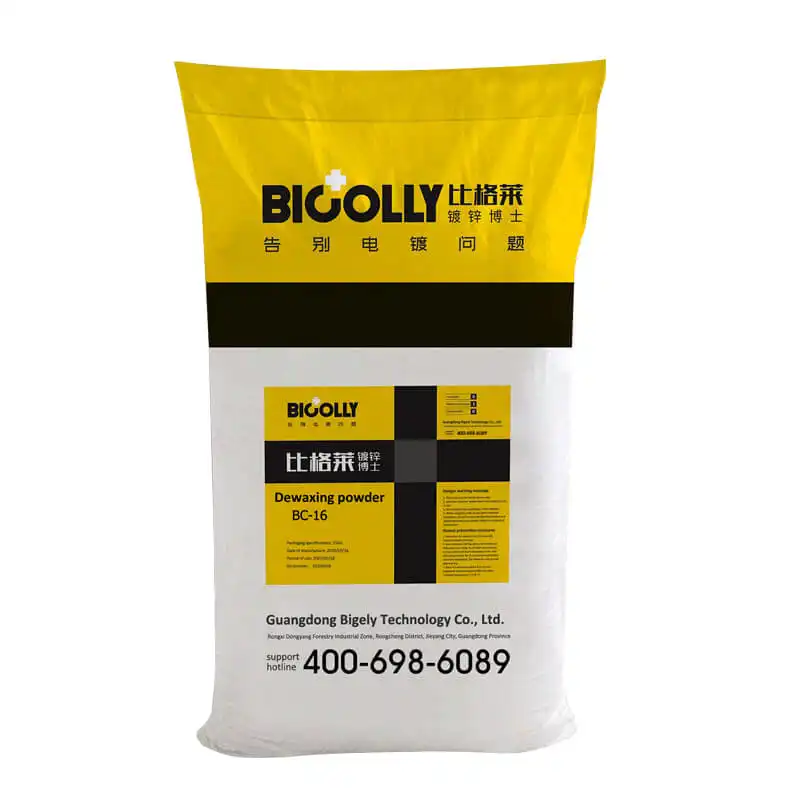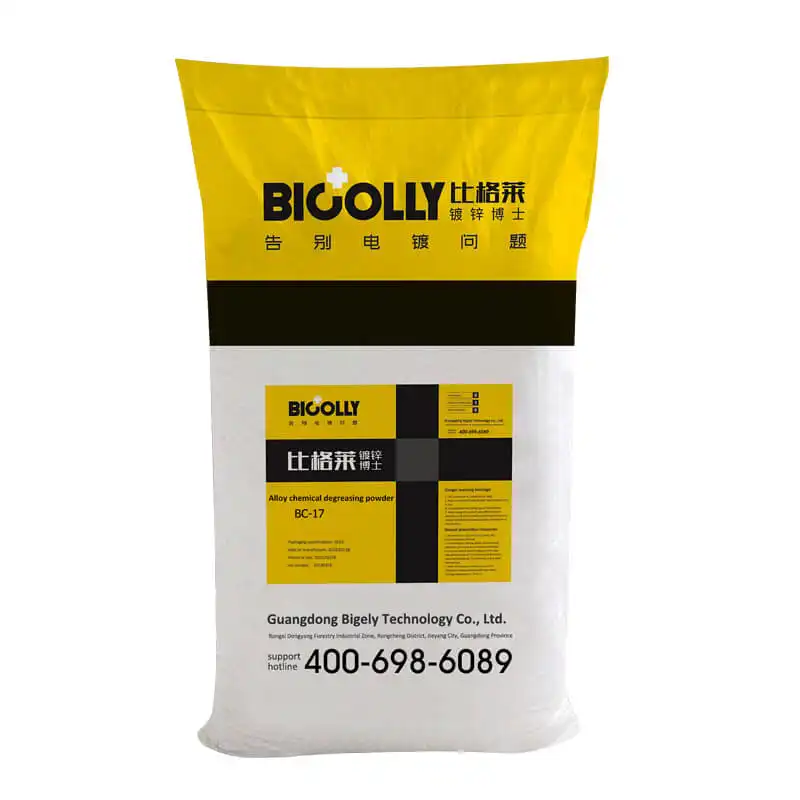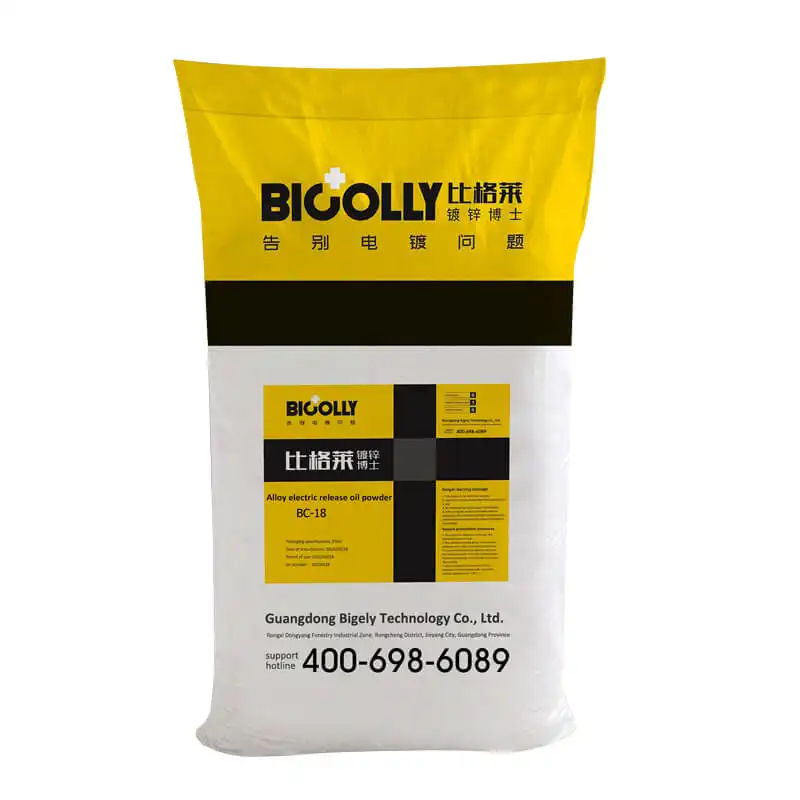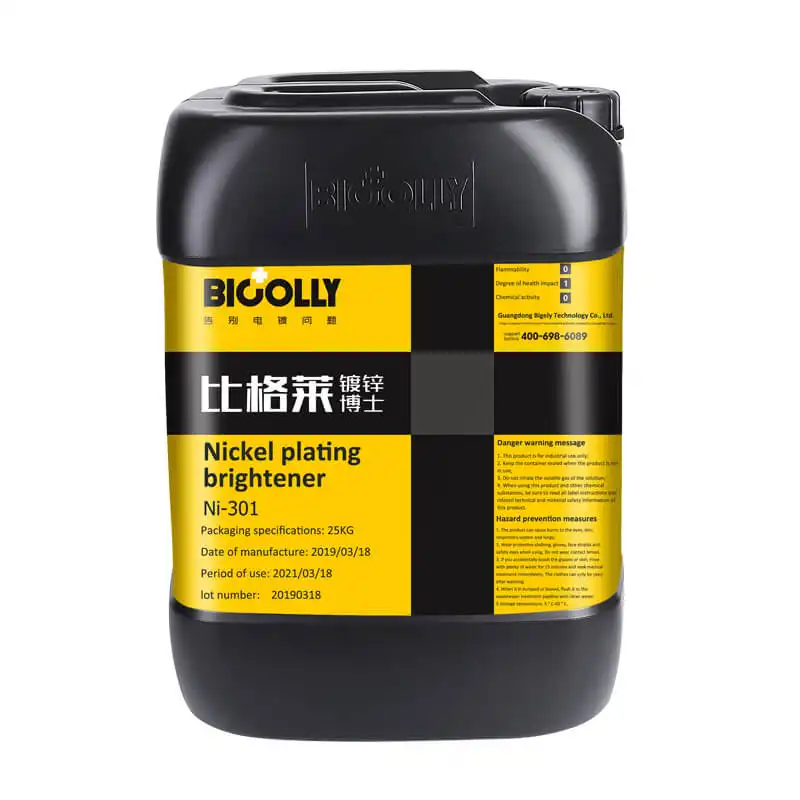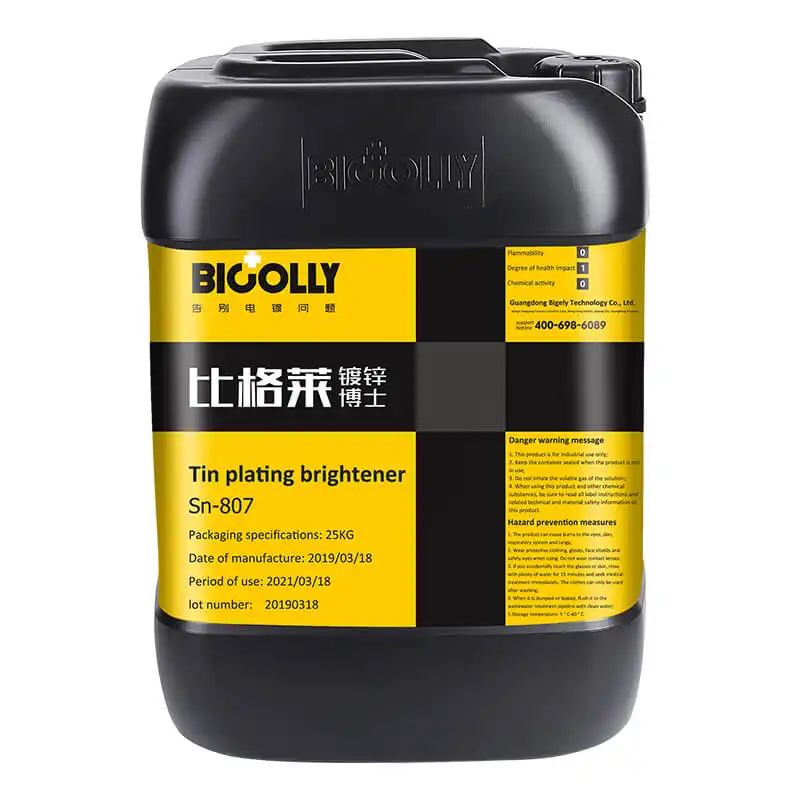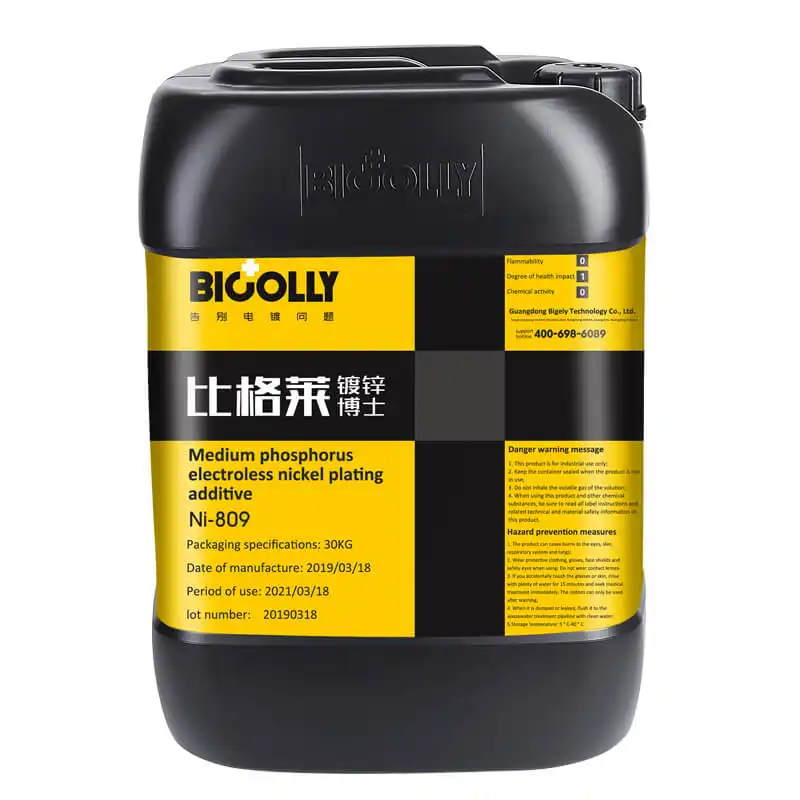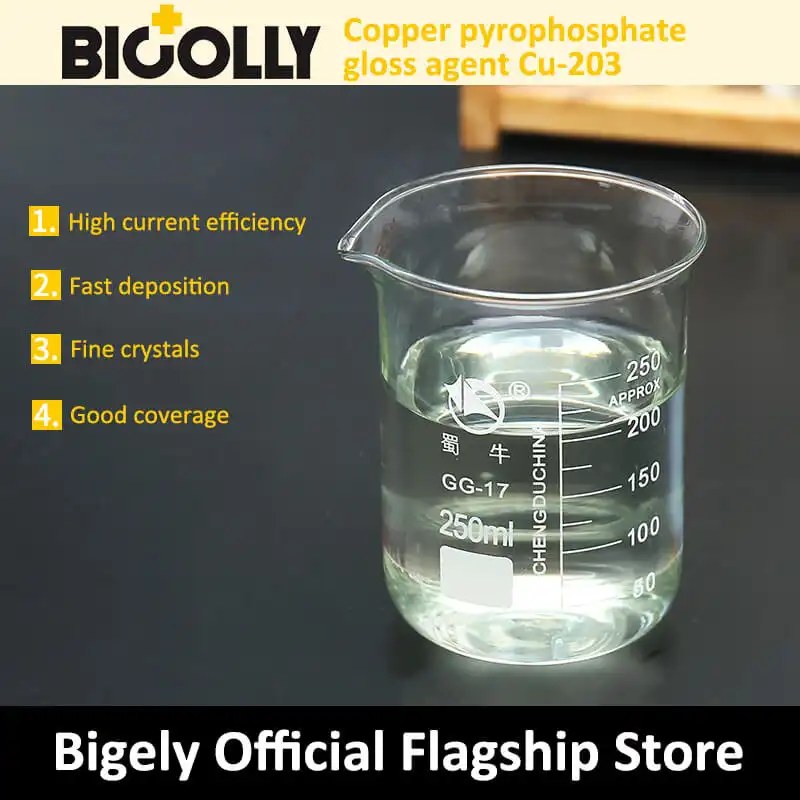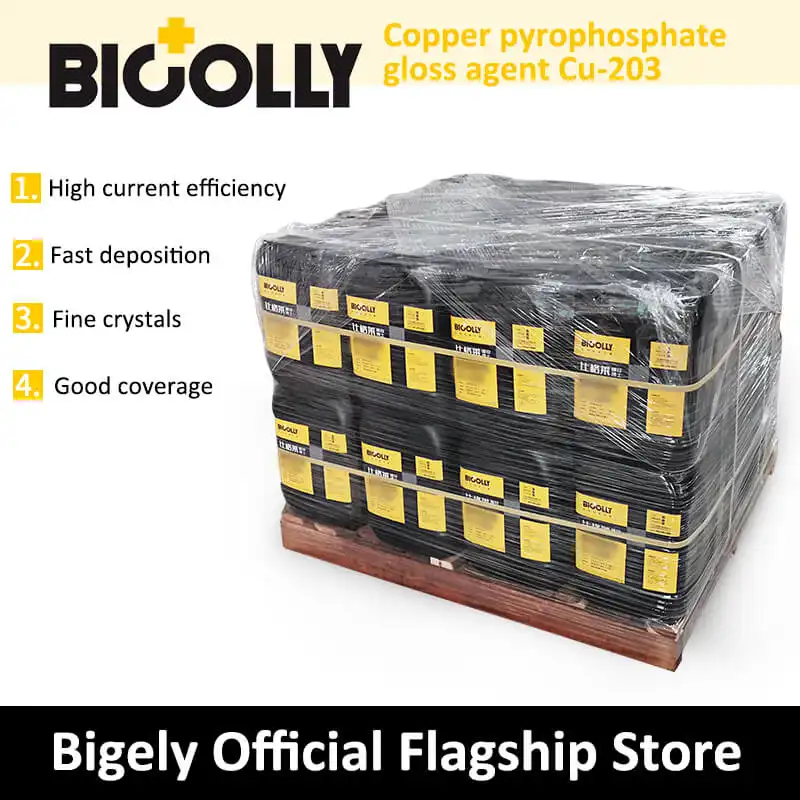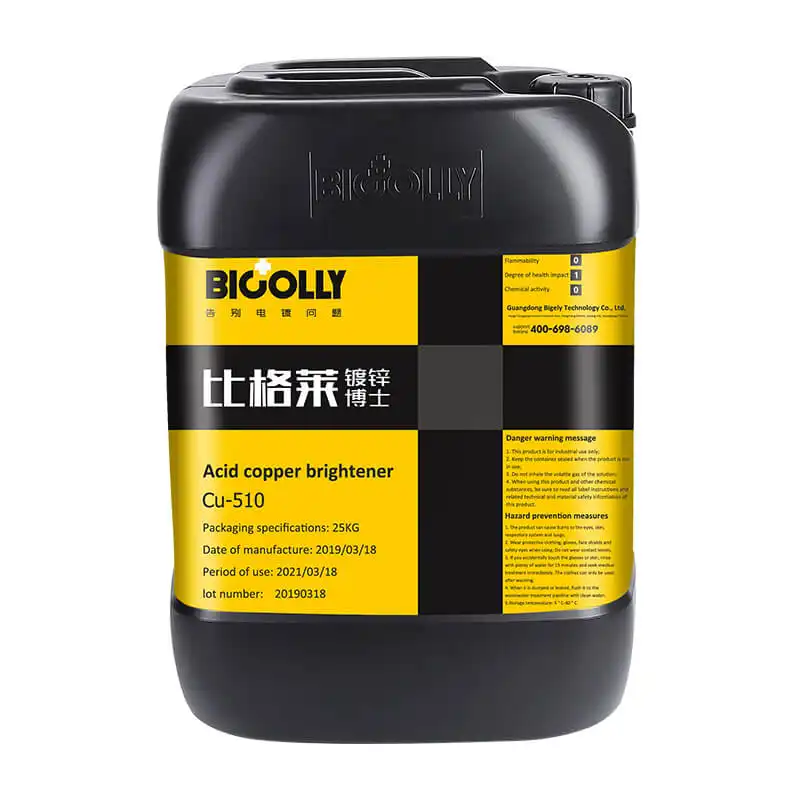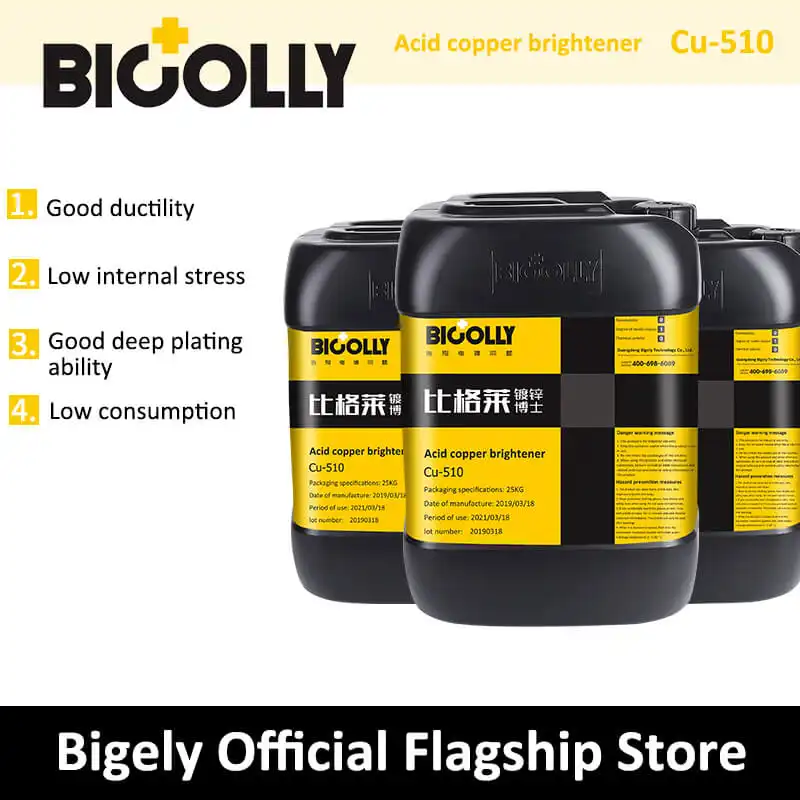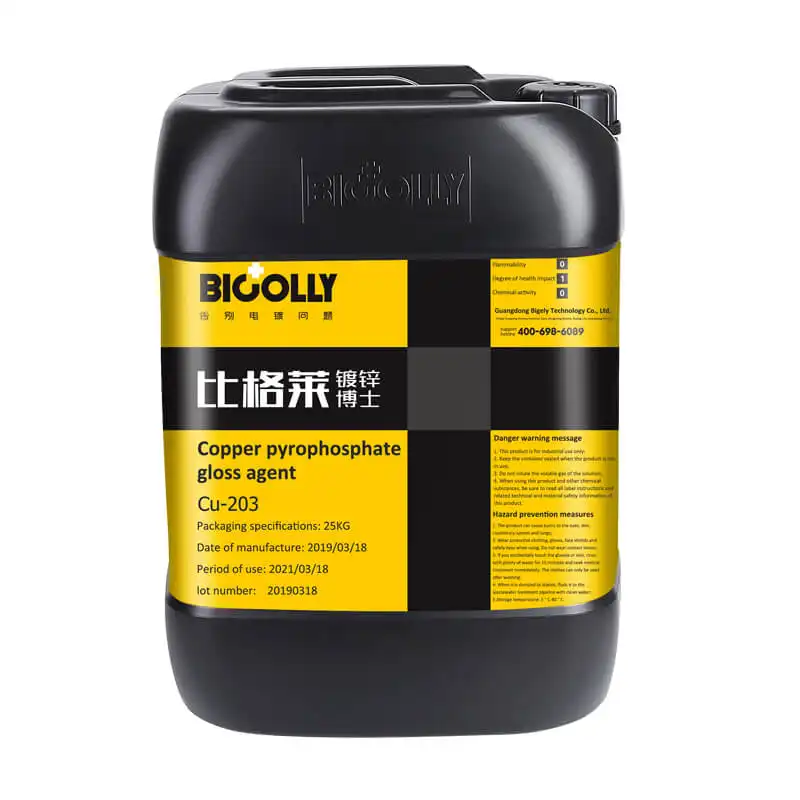Copper pyrophosphate gloss agent
C u-203 copper pyrophosphate brightener
Description : Cu-203 is a new light pyrophosphate copper process, this process can be produced green bright and smooth copper plating, especially for decorative plating.
characteristic
· Bright and flat copper plating
· Bath construction and maintenance are simple
·It can save expensive nickel plating layer in decorative electroplating
· No cyanide
· Very suitable for zinc die castings
1. Bath parameters
|
parameter |
range |
best value |
|
Temperature℃ |
50-60 |
55 |
|
Current density ( Adm 2 ) |
3-6 |
3.5-4 |
|
pH |
8.6-9 .2 |
8.8 |
|
Copper ion ( g/L ) |
20-30 |
twenty four |
|
Total P 2 O 7 4- ( g/L ) |
130-225 |
165 |
|
Ammonia ( g/L ) |
0.8-1.0 |
0.9 |
|
P ratio |
6.4 : 1-7.5 : 1 |
Determined by Cu 2- |
2. Maintenance of bath liquid
|
additive |
Numbering |
Add frequency |
|
Brightener |
Cu-203B |
1.7-2.5 liters per 10KAH |
|
Opener |
Cu-203A |
Add after bathing or purification |
|
ammonia |
|
Add 0.06ml/L of ammonia with a specific gravity of 0.880 every hour |
Copper & Potassium Pyrophosphate
It is very important to maintain the concentration of potassium pyrophosphate, otherwise the brightness range of the coating will be reduced due to scorching in high current density areas and darkening in low current density areas.
The low ratio of potassium pyrophosphate to copper ions will reduce the conductivity of the solution, thereby affecting the anode efficiency.
Since the addition of copper ions and potassium pyrophosphate are closely related, the frequency of addition of the following additives should be observed and analyzed:
For every 1g/L reduction in copper ion , add 2.82g/L copper pyrophosphate trihydrate. According to this method of addition, the total amount of pyrophosphate can be increased by 1.353g/L . If 1g/L copper pyrophosphate is added , the total pyrophosphate will increase by 0.48g/L .
If pyrophosphate is lower than the recommended value of 1g/L , you can add 1.9g/L of potassium pyrophosphate.
If the analysis apparatus with insufficient counter, to follow 3 : 1 ratio (weight ratio) to add potassium pyrophosphate and copper pyrophosphate.
If the copper ion concentration exceeds 24g/L , the total pyrophosphate concentration should be maintained between 6.4-7.5 times the copper ion concentration .
For example, if the concentration of copper ion is 20g/L , the concentration of total pyrophosphate should be 128-150g/L . If the copper ion concentration is 30g/L , the total pyrophosphate concentration should be between 192-225g/L .
ammonia
Add ammonia to compensate for the loss caused by volatilization. The concentration of ammonia is judged by smell. The typical addition rate is 0.06ml/L of ammonia (specific gravity 0.880 ) per hour .
Brightener Cu-203B
The brightness and flatness of the coating are maintained by regularly adding Cu-203 B brightener and ammonia. It is best to add it automatically. The two can be mixed in the correct ratio and then diluted 10 times before adding to the bath. When diluting, be sure to dilute with deionized water.
Brightener is added 2 to 3 times per work shift , 0.1-0.2ml/L each time to maintain the brightness of the coating. The total daily addition depends on the number of plated parts. Calculated according to the minimum load, the consumption rate is about 2L per 10,000 ampere hours . Additional additions are usually carried out on weekends or during free time.
Cylinder opening agent Cu-203A
It is used after the bath and bath liquid is purified, and usually does not require maintenance.
pH
The pH should be controlled within the range of 8.6-9.2 , and should be checked regularly with an electronic pH meter or pH test paper.
The pH will rise slightly during the electroplating process, and 10% dilute sulfuric acid can be added to reduce it. After adding ammonia or main salt, re-measure the pH value of the bath .
3. Bathing procedure
Preparation of the tank
When using a new tank, use a special plastic such as Vulcron . In addition, the tank should be soaked in alkali ( NaOH 10g/L ) for 8 to 12 hours. During this process, the temperature of the alkaline solution must be maintained at 50-60 ℃, and filtered.
If the nickel-plated tank is used to convert the coke copper process , please use the following procedure.
1. Use hot water to clean the tank and peripheral equipment, including filters, preparation tanks, etc.
2. Soak the plating tank, add 20g/L dilute sulfuric acid and 2-3g/L activated carbon, keep the temperature at 60 ℃, and stir for at least 8 hours.
3. Drain the acid and wash the tank and peripheral equipment with water.
4. Soak the plating tank and peripheral equipment with 1% NaOH ( 10g/L ) solution, keep the temperature at 50-60 ℃, and soak for at least 12 hours.
5. Drain the alkaline solution and rinse with water. Prepare the tank.
|
drug |
range |
best value |
|
Anhydrous potassium pyrophosphate SF41588 |
230-270g/L |
25 0 g/L |
|
Copper pyrophosphate trihydrate SF41297 |
65-75 g/L |
70 g/L |
|
Ammonia ( 0.880 sp.gr. ) |
3-5ml/L |
4 ml/L |
|
Cu-203A cylinder opener |
2-3 ml/L |
2.5 ml /L |
|
Cu-203B brightener |
0.2-0.4 ml/L |
0.25 ml/L |
Slot matching program
When preparing the tank liquid, if the local water quality is hard, it is best to use soft water. Usually deionized water is used to build the bath.
The recommended slotting procedure is as follows:
1.Add water ( 40-50 ℃) to about 1/2 tank volume, add the required potassium pyrophosphate under stirring to make it completely dissolved.
2.Add the required copper pyrophosphate, which should be added in batches with stirring to prevent the temperature from rising too fast.
3.After the copper pyrophosphate is completely dissolved, add cold water to the operating level, adjust the pH to 8.6 with 50% dilute sulfuric acid, and the amount of concentrated sulfuric acid should not exceed 2.5ml/L . Cool the tank liquid to 50-55 ℃, add the required ammonia water.
4.Ammonia (specific gravity 0.880 ) must be diluted before being added to the bath. Circulate filtration until the tank liquid is clear.
5.Add the required Cu-203A cylinder opener, dilute it 10 times before adding it to the tank.
6.Add the required Cu-203B brightener, this substance does not need to be diluted before adding.
7.Reconfirm the pH value, if necessary, adjust it to 8.6 before use.
4. Equipment
Trough
It is recommended to use PVC lining or rubber lining.
The tanks that have been used for glossy nickel or acid copper should be treated with the above suggestions when building the bath.
Heater
Use titanium or quartz immersion electric heater. When using the heater, the bath liquid must be stirred with air. In addition , make sure that the liquid level is normal and the heater is immersed below the liquid level.
The heater must be cleaned regularly to remove the film formed on the quartz during the electroplating process.
filter
The filter is installed with Dispak Filter Pads M.30713 or polypropylene filter bags. When using filter bags, filter aid Filter Aid Powder N.41352 is better. In areas with hard water quality, it is recommended to filter continuously at 1Turn per hour . Normally, only regular filtering is required. When slight organic pollution appears or is suspected, use Zonax activated carbon to recycle and filter for several hours before use.
Air agitation
The plating tank must be equipped with a plastic air stirring tube. When working at the maximum current density, use strong air agitation. Under special requirements of workpieces, cathode swing can be used.
anode
It is recommended to use OFHC copper anode. If not, an oval electrolytic copper anode can be used instead. The area ratio of the anode to the cathode is about 1.5 : 1 , and the anode current density is 1.6-3amp/dm 2 . The anode surface should be kept clean. If there is a thick and scattered film in the bath, it means that the anode current density is too low.
5. Pretreatment process
PyroMac cannot be used directly on steel or zinc die-cast substrates. Usually copper cyanide or nickel is used as a primer, but it can be directly applied to the Bondal process of aluminum processing .
|
Steel recommended process: |
Suggested process for zinc die casting: |
|
1. Immersion thermal degreasing |
1. Immersion thermal degreasing |
|
2. Anode electrolytic degreasing |
2. Anode electrolytic degreasing |
|
3. Double washing |
3. Double washing |
|
4. Acid leaching ( HCl ) |
4. Solid acid |
|
5. Double washing |
5. Double washing |
|
6. Flash copper plating ( Coprax or Zonax ) |
6. Flash copper plating ( Coprax or Zonax ) |
|
7. Or flash nickel |
7. Double washing |
|
8. Double washing |
8. PyroMac plating |
|
9. PyroMac plating
|
|
6. Troubleshooting
1.Poor gloss
( A ) Cu-203B brightener is insufficient, add 0.2ml/L of brightener .
( B ) If the ammonia content is insufficient, add ammonia water 2ml/L , but it should be diluted before adding.
( C ) For cyanide pollution, add 1.25ml/L of hydrogen peroxide for treatment. Dilute the hydrogen peroxide before adding it, and use air stirring to make it evenly dispersed in the tank. If copper cyanide bath is used, it is recommended to implement H 2 O 2 treatment once a week .
Reduce the carry-out of cyanide to reduce cyanide pollution.
2.Poor gloss in low current density area
( A ) The temperature is too high, lower the temperature.
( B ) Excessive ammonia water, increase the temperature to volatilize the ammonia water (the temperature should be lowered back to the normal working range before reuse).
( C ) P 2 O 7 4- is too low, check the composition.
3. Scorching in the high current area
( A ) is less than the blowing, plus a strong blast, adjust the position of the duct.
( B ) The temperature is too low, adjust the temperature.
( C ) P 2 O 7 4- is too low, check the composition.
4.Stepped or waved coating in low current area
If the gloss agent is excessive, if it is only slightly excessive, increase the temperature, strengthen the blast, and increase the current density for electroplating. The quicker method can add 2.5ml/L of Cu-203A cylinder opener (but if the low current area is already very dark, do not add).
If a considerable amount of Cu-203B brightener is added by mistake, it is regarded as organic pollution, and activated carbon is used to filter it.
5.Organic pollution
Activated carbon filter treatment, then add 1.2ml/L Cu-203A cylinder opener and 0.25ml/L Cu-203B brightener . If the bath using 1g / L of activated carbon to the batch processing process, open cylinder agents and brightener is consumed, so bath agent to be by open cylinder re-addition.
6.Chromium pollution
Hexavalent chromium pollution will cause irregular "fog spots" on the surface of the coating. Therefore, this pollution must be prevented.
The contacts of bad hangers or fixtures will bring in chromium and be contaminated. Weak electrolysis can be implemented. The anode current density is 1amp/dm 2 , which can reduce hexavalent chromium to trivalent.
 Products
Products